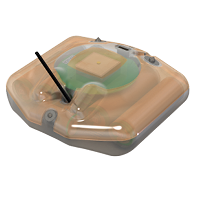
Features
- Argos
- Fastloc GPS
- Depth
- Temperature
- Optional Light Level

WEIGHT
210 g
LIFE
485 days
DIMENSIONS (mm)
85 x 85 x 27
Key Benefits
The SPLASH10-F-296 is a data-archiving satellite transmitting tag designed for tracking vertical and horizontal movements of free-range marine animals.
It is Fastloc that sets this tag apart:
- Highly accurate—to 20 m with optimal satellite coverage.
- Fast acquisition—even after prolonged sleep, a location can be acquired in a fraction of a second. Very little surface exposure is needed.
- All acquired GPS snapshots are stored for validation post-download.
- Flexible scheduling—fixes can be scheduled at regular intervals or duty-cycled depending on day or season.
- Many locations are possible—hundreds achievable per day for a higher resolution track.
Argos
Fastloc GPS
Depth
Temperature
Optional Light Level
Key Features
- Highly Customizable Data Collection and Transmitting Schedule—users can customize and prioritize data transmissions. Deployments can be tailored to achieve unique experimental objectives. Flexible transmissions provide the ability to extend the life of the tag by focusing on specific seasons or times of the year.
- Full Data Archive Available on Recovery—SPLASH10-F tags contain one GB of onboard memory for archiving data. This means when you recover your tag, your full data set is available, even if the battery is dead—data are maintained in the archive for up to 25 years.
- The Portal Advantage—SPLASH10-F tags are supported by the Wildlife Computers Data Portal, a collection of data management tools and services. Developed specifically for the display and investigation of data from Wildlife Computers tags, the data portal streamlines the processes of acquiring, preserving, and sharing data services. The portal helps collect, prepare, and analyze the data returned from the tag— via Argos or the archive. Data are easily sorted, filtered, searched, uploaded, and shared. You can see a Google Earth display of your deployment track, color-coded to show the relative age of each location. You can also set up a live KMZ to get data into your own monitoring system.
